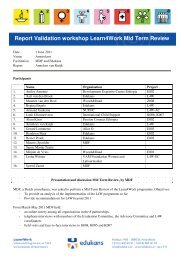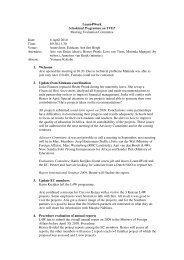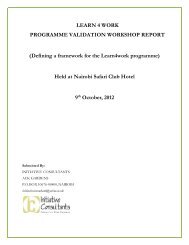DRAFT TECHNICAL AND VOCATIONAL EDUCATION AND ...
DRAFT TECHNICAL AND VOCATIONAL EDUCATION AND ...
DRAFT TECHNICAL AND VOCATIONAL EDUCATION AND ...
Create successful ePaper yourself
Turn your PDF publications into a flip-book with our unique Google optimized e-Paper software.
17<br />
15-24 year group. The level of unemployment drops to single digit for both male and female<br />
from 35 years and above. The magnitude of the youth unemployment problem is echoed in<br />
the Education Sector Performance Report 2008 that “Youth constitute the majority of the<br />
unemployed, although they make up only 18 percent of the total population and 37 percent of<br />
the economically active population” (MoESS, 2008, p. 137)<br />
Table 3.7 Unemployment by Age Groups, 2000<br />
Age Group Both Sexes Male Female<br />
15 – 19 17.0 17.0 17.0<br />
20 – 24 19.1 18.7 19.5<br />
25 – 29 14.2 13.8 14.7<br />
30 – 34 9. 9 9.3 10.4<br />
35 – 39 7.8 7.5 8.1<br />
Source: Ghana Statistical Service (2005). Population Data Analysis Report, Volume 1:<br />
Socio-Economic and Demographic Trends, p. 105.<br />
Approximately one million people responded during the nationwide registration of the<br />
unemployed and underemployed in 2001 (Nsowaah-Nuamah & Amankrah as cited in Ghana<br />
Statistical Services, 2007, p. 73). The profiles of those registered are summarized in Table<br />
3.8. An astonishing 66.3% of the females who registered had completed basic education but<br />
were unable to continue or complete “pre-tertiary post basic”. This category of females also<br />
constituted roughly 66% of the total number of people registered. Under-employment among<br />
females is visible on the streets and in the open markets of the big cities in Ghana. Hundreds<br />
of women sell very small quantities of items such as oranges, second-hand clothes, toys,<br />
biscuits, bread, apples, sachet water, and the like wherever there is human traffic, including<br />
road construction sites and vehicle toll collection points. One can conclude from the figures<br />
in Table 3.8 that unemployment/underemployment has a great deal to do with illiteracy, early<br />
dropping out of school or not having any skill training.<br />
Table 3.8 Profiles of the Unemployed Youth in Ghana’s Labour Market, 2001 (Percentages<br />
Category of Unemployed Male Female Total<br />
Illiterate, due to early drop out of school or no<br />
schooling at 20.8 23.2 21.6<br />
Have acquired some skill through some vocational<br />
training, especially apprenticeship but need<br />
6.6 3.5 4.7<br />
retraining<br />
Have completed at least basic education but unable<br />
to enter or complete pre-tertiary post basic 2.3 66.3 65.8<br />
Have completed Senior Secondary School but<br />
unable to go further due to failure in English, Maths<br />
and Science at SSSCE<br />
Graduates from universities and polytechnics,<br />
majority first time job seekers without the required<br />
work experience<br />
1.6 5.2 4.7<br />
2.8 0.6 1.2<br />
Street youth, including Kayayei who live, sleep and<br />
work on the streets and others 2.8 2.2 2.5<br />
Total 100.p 100.0 100.0<br />
Number 524,028 378,437 903,437<br />
Source: Nsowaah-Nuamah and Amankrah (as cited in Ghana Statistical Service, 2007, p. 74)







